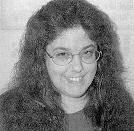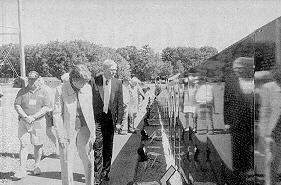By Liz Premo, Atlantic News Staff Writer
Atlantic News, June 21, 2001

Like the recently-released movie entitled “Pearl Harbor,” Hollywood productions often present characters who are partners in a love story that is set against a backdrop of wartime circumstances. The stories will touch briefly upon the drama of war, but don’t always reflect the true story of the danger, the horror, the bloodshed, the loss of life experienced by American soldiers, and the ways their families and friends back home were affected by it all.
Sometimes it’s just too painful to recall and remember any of it.
But it’s that same recollection and remembrance that oftentimes helps to bring healing to the hearts, minds and souls of those whose lives have been touched in one way or another by the horrors of war. And sometimes meeting the pain face-to-face — and allowing it to be washed away by the tears it inevitably brings — can help that healing begin.
Recently my husband and I went to see ‘The Wall that Heals,’ a half-size replica of the Vietnam Veterans Memorial that stands in Washington, DC. This traveling exhibit was stationed for several days at the Pease Tradeport, and over the course of the weekend the presence of the memorial was observed by speeches, religious services, a wreath-laying ceremony, and a visit by NH Governor Jeanne Shaheen and US Congressman Richard Gephardt.
Individuals of all ages could be seen on the grounds, viewing military exhibits, listening to a children’s choir, and taking time to linger at the Wall. There were tearful embraces between the fallen’s fellow veterans, families and friends who were present. There were whispered prayers and remembrances; and countless fingertips seeking names from the more than 58,000 men and women who are memorialized on the Wall’s glossy black surface.
There was also a hushed yet palpable sense of pride, sorrow, respect, reverance and, yes, healing.

We found the names we sought — Private First Class Paul Randolphe Byrne (USMC), my husband’s cousin, killed at age 21 by non-hostile (“friendly”) fire on December 11, 1966 in Quang Nam, South Vietnam, and Colonel James Wimberley Lewis, an Air Force Reserve pilot shot down over Laos on April 7, 1965, an assumed prisoner of war.
{Atlantic News Photo by Liz Premo}]
It was Cal. Lewis’ name that was inscribed on a POW bracelet which I had possessed since the very early 70s — the very same bracelet which I clutched in my hand, along with the purple iris I had brought from my garden, to eventually leave at the Wall that day.
I was surprised at my reaction when I finally saw Cal. Lewis’ name, inscribed near the Wall’s vertex. Here I had never known or met or spoke to the gentleman, yet carrying his name around on my wrist for all those years had created a connection which I hadn’t realized had existed. I tucked the stems of the purple iris into the blanket of small pebbles that ran along the base of the Wall. I touched his name. I said a prayer. And I felt a few quiet tears come.
A volunteer saw me dabbing at my eyes, and asked if I needed a tissue. “Yes, please. Thank you.” She offered to direct me to a nearby tent where counselors were stationed, available to talk with and comfort those who were overcome by grief and painful memories their visit to the Wall evoked.
“No, thank you, but I would like to leave this here,” I said, indicating a typed essay I had written a while back, explaining the symbolism of the POW bracelet. The essay, and my POW bracelet, had been a classroom show-and-tell subject for one of my daughters back when the Persian Gulf War was raging. I felt it was proper to leave it behind.
Leaving the POW bracelet was far more difficult, and I hesitated. But I realized that it was a fitting and honorable and respectful gesture to finally let it go. Soon the paper and the bracelet were both placed in a sealed plastic bag, tagged with a label indicating that they be sent to the Washington-based Vietnam memorial. They were laid at the base of the Wall, next to other flowers, mementos, photographs, poems, miniature flags and major memories which other visitors had contributed. Time was taken for another quiet moment of reflection, before it was time to head for home.
Thus I finally said “good-bye” to Col. James Wimberley Lewis — a man I never met but felt I knew. A man who gave the ultimate sacrifice like so many others in America’s past who have fought for liberty and freedom. A man whose name is forever etched in my mind — and on Panel 1E, Line 102 of the Wall That Heals.